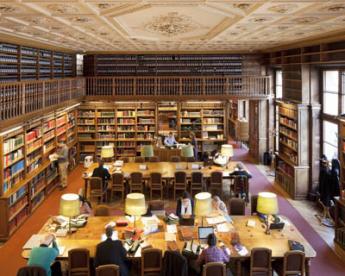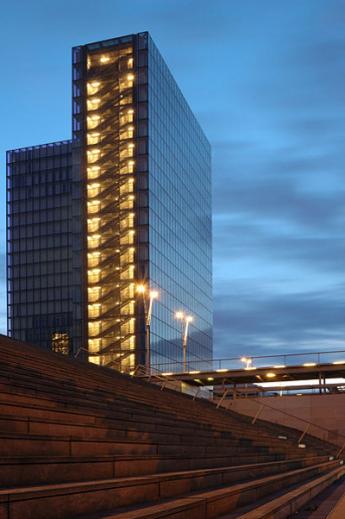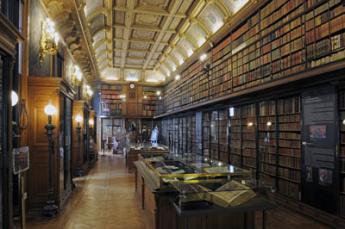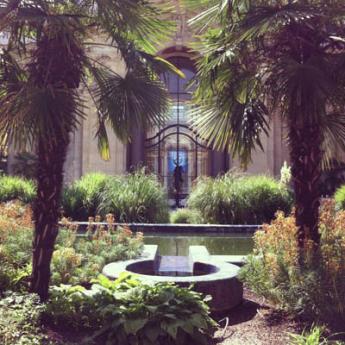Actualités Syndicat National de la Librairie Ancienne et Moderne
Paris 2014 - Congress Program

41st ILAB CONGRESS, APRIL 13-16, 2014
The 41st ILAB Congress was preceded by the Salon International du Livre Ancien and 25th ILAB International Antiquarian Book Fair from 11th to 13th April 2014 at the Grand Palais (Paris). The program:
Sunday, 13th April 2014
THE FINAL DAY OF THE SALON INTERNATIONAL DU LIVRE ANCIEN AND 25th ILAB INTERNATIONAL ANTIQUARIAN BOOK FAIR
2 – 6 pm: Reception for Congress participants in the VIP area of the Grand Palais
2 pm: Official welcome during the International Antiquarian Book Fair, at the stand
“Exposition centenaire du SLAM – Congrès 2014”
8.30 pm: Welcome cocktail party in the France-Amériques suites of the Hotel Marois, Salons de l'Association France-Amériques
In 1863, the Count of Marois, son of General Le Marois, was a key aide to Napoléon I and witness to his marriage with Joséphine de Beauharnais. He left his former home on Rue Blanche and settled in the quarter of the Champs-Elysées. This beautiful home on the Avenue Franklin Roosevelt remained in the Marois family until 1927, when Countess Jacques-André de Ganay Le Marois sold the property to the Association Franco-American.

Monday, 14th April 2014
BIBLIOTHÈQUE DE L’ARSENAL AND BIBLIOTHÈQUE NATIONALE DE FRANCE (BNF)
10 am: Visit and tour of the Arsenal Library
A public library since 1797, the Bibliothèque de L'Arsenal has been affiliated with the Bibliothèque nationale de France since 1934. The collection originated from the library of Antoine René d'Argenson, Marquis of Paulmy, and was held in the home of the Grand Masters of the Artillery at the heart of the old Arsenal of Paris. Paulmy gathered a vast, encyclopedic collection of books, manuscripts and prints which was sold to the Count of Artois, brother of Louis XVI, in 1785. Throughout the 19th century the collection was more orientated towards literature and the theatre particularly under the guidance of its famous directors Charles Nodier and José-Maria de Heredia. Today the Arsenal Library holds a rich collection of books, prints and manuscripts on arts, art history, photography, history, literature, music, religion and political science, along with special collections on the history of books and bibliophily.
noon: Lunch at the restaurant Café Bibliothèque, near the National Library of France
2 pm: Visit of the National Library of France with three tours:
1. The Treasure of Books – special exhibition organized by Antoine Coron, director of the Rare Books Reserve
2. The Coronelli Globes – constructed by Vincenzo Coronelli at the end of the 17th century for Louis XIV
3. The Great War 1914 – 1918 – exhibition of the National Library of France
The Bibliothèque nationale de France (BNF) is home to a vast number of collections dating from the end of the Middle Ages up to the present time. The National Library traces its origin to the royal library founded by Charles V in 1368. In 1537, François I. introduced a new law stating that all printers and booksellers had to provide a copy of each book printed and sold in France to the library of Blois Castle. This obligation, known as the legal deposit, constitutes a fundamental step towards the creation of the Royal Library. The Abbot of Bignon, who became Librarian to the King in 1719, gave the library an unprecedented brilliance. He installed the library in Paris in the Rue Richelieu and acquired numerous documents and books which were milestones in the history of Europe and its intellectual development. During the French Revolution the Royal Library was declared national property and it was renamed to Bibliothéque nationale. Its treasures increased considerably thanks to the confiscation of private aristocratic collections, among them the libraries of Louis XVI and Marie-Antoinette. From then on the Bibliothèque nationale de France has been continually growing. By 1920 the collection had already increased to 4.050.000 volumes and 11.000 manuscripts. On 14th July 1988, the French President François Mitterrand announced “the construction and organization of one of, if not the largest and most modern libraries in the world... (which) will cover all fields of knowledge”. On 20th December 1996, this project was finished with the official opening of the new BnF.
7 pm: Evening reception and dinner cruise on the Seine


Tuesday, 15th April 2014
THE CASTLES OF ECOUEN AND CHANTILLY
9 pm: Day trip to Ecouen Castle and Chantilly Castle
10.30 am: Visit of the Museum of the Renaissance in Ecouen Castle, and visit of the library
Built in 1538, Ecouen Castle is an architectural gem of 16th century France. It houses the National Museum of the Renaissance with an impressive collection of paintings, sculptures, furniture, and tapestries. The museum also exhibits one of the earliest copies of the Leonardo da Vinci’s masterpiece The Last Supper.
noon: Lunch at the Domaine de Chantilly
2 pm: Visit of Chantilly Castle and its book cabinet, library and gardens
Since the Middle Ages the Domaine de Chantilly has belonged to great royal families of France. The library and archives of Chantilly Castle keep the numerous books and written documents collected over the centuries by the Lords of Chantilly, family members of Montmorency and Bourbon-Condé, and by the Duke of Aumale. An erudite 19th century bibliophile, the Duke of Aumale is one of the most important French book collectors of that time. The unique collection comprises 44.000 books including 700 incunabula, 1500 (and 500 illuminated) manuscripts. The book cabinet, constructed between 1876 and 1877 by Honoré Daumet as a presentation room and a place for reading and work, does not only include 19.000 volumes, 1500 manuscripts and 17.500 prints, but also one of the most precious manuscripts in the world: Les Très Riches Heures of the Duke of Berry.
afterwards: return to Paris, evening free


Wednesday, 16th April 2014
DUTUIT COLLECTION AT THE PETIT PALAIS AND BIBLIOTHÈQUE MAZARINE
10 am: Private exhibition of the Dutuit Collection in the Museum of Fine Art at the Petit Palais, opposite to the Grand Palais
Built by Charles Girault for the Exposition Universelle in 1900, the Petit Palais houses an impressive collection of paintings, sculptures, objets d'art and furniture as well as a remarkable ensemble of manuscripts and 15th to 19th century books and prints. These works belong to the Dutuit Collection, donated to the city of Paris in 1902 and since then kept in the Petit Palais. The Dutuit brothers authored a number of works on engraving, which explains why their collection includes a great deal of illustrations : livres d'heures, exceptional prints, danses macabres and other rare and magnificent items such as manuscripts by La Fontaine and an original edition of Michel de Montaigne’s Essais, of which Nodier said that if he had to keep one book it would be this one.
noon: Lunch at the Restaurant Alcazar
3 pm: Visit of the Bibliothèque Mazarine, conducted by curator Yann Sordet
The personal library of Cardinal Mazarin (1602-1661), former minister of Louis XIV, was made open to the public in 1643; thus it is the oldest public library in France which had kept over 40.000 volumes as early as 1652. During the French Revolution the Bibliothèque Mazarine received confiscated private collections due to Abbé Gaspard Michel. Since then the library has been permanently growing through the acquisition of new books, the legal deposit and significant donations. Affiliated in 1945 with the Institut de France, the Mazarine is now one of the most important literary and scientific institutions of the Ministry of Education owing rich collections of 16th to 18th century encyclopedias, 19th to 20th century history books and medieval manuscripts.
8 pm: Farewell dinner at the Automobile Club of France
(Pictures: Courtesy of SLAM. © Eric sempé / BnF, © Alain Goustard / BnF, Bibliothèque Mazarine (cliché Nicolas Fève - CC-by-nc-nd))

